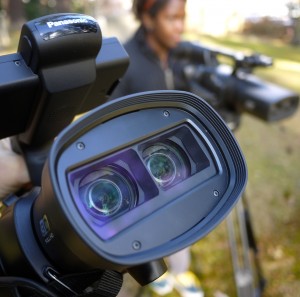 The Right Interaxial For You
The Right Interaxial For You
It’s not a stupid question. Consider the major strength and weakness of the Panasonic 3DA1 is its orthostereoscopic 60mm interaxial. On the one hand by matching a human being’s interocular distance, we can be assured that objects captured at a “normal” distance with a “normal” lens will appear with a “normal” roundness from a human being’s perspective. This is critical if we as shooters are to be successful in our 3D endeavors: capturing your leading lady or young starlet with her head shaped like a medicine ball will not do much for your career.
On the other hand the 60mm interaxial can be limiting; objects approaching well inside of ten feet (3m) may cause severe eye strain; the hyperconvergence inducing headaches, nausea and a flight to the exits. This is because the converging of the eyes requires musular effort, which increases dramatically with diminishing object distance. A similar peril exists on the other side of the screen in positive space. The 60mm IA increases the risk of hyperconvergence; a condition audiences particularly loathe as they try to splay their eyes out like Marty Feldman.
Panasonic’s new 3D camcorder HDC-Z10000 effectively reduces the risk of hyperconvergent and hyperdivergent conditions. By shrinking the interaxial to 42mm the economical 3D model ($3500 list) will allow comfortable capture of objects down to a mere 17 inches (45cm). This means the Z10000 will prove more useful in the critical six to eight foot (1.5m – 2.5m) range where we shooters tend to do most of our work.
The down side of the narrower IA is the noticeable loss of depth beyond fifteen feet (4.5m). This may be fine if working primarily on sets or for shooting sit-down intereviews when coupled with the wider than normal (32mm equivalent) lens. This is a critical point. Shooting with the Z10000 and a “normal” lens will yield the approximate point of view of a small dog or cat whose interocular distance is 42mm. Maybe this is what you want, maybe it isn’t. The point is to know what the heck you are doing: The narrow IA decreases roundness from a human perspective; the wider field of view gained from the 32mm equivalent lens increases roundness to restore the human perspective.
The design of the Z10000 with its lofty ridiculous model number is designed to do exactly that.

Panasonic's Z10000's 42mm interaxial allows comfortable close placement of objects as close as 17 inches (45cm) but beware the loss of the human perspective; we see the world with our eyes about 65mm apart and so our 3D camera and storytelling skills must be adjusted to ensure capturing objects with the proper desired roundness.